The Bahamas is a Caribbean nation that is made up of more than 3,000 islands. The unique history of this beautiful country has been severely affected by colonialism. After Christopher Columbus landed here in 1492, the country became nearly deserted from 1513 to 1648 as almost all the native Taíno people were enslaved or died of diseases brought by colonizers. After it became a British colony, both British colonizers and Americans who were loyal to the British crown after the Revolutionary War moved there, bringing enslaved Black people with them. When Britain abolished slavery in 1807, the Bahamas became a haven for Black people, especially people who were rescued from slave ships and who escaped from slavery in the American south during the 1800s.
This stunning history may seem unrelated to the flora and fauna of this country. Still, it is necessary to understand the unique culture as it relates to every part of this nation, including the importance of fish and fishing, and how fish are used in cuisine. What kinds of fish are popular in the Bahamas? Keep reading to find out!

1. Bonefish
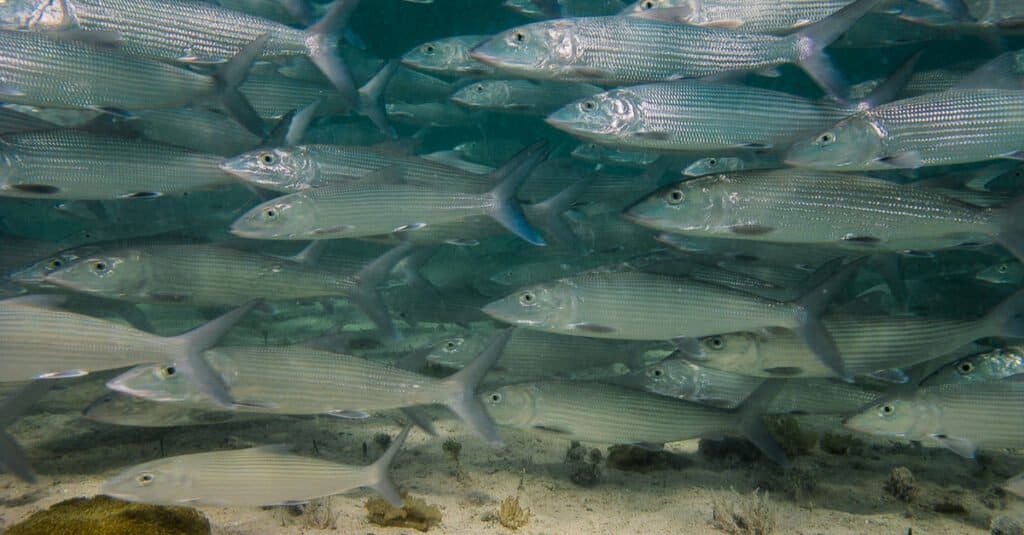
The bonefish are relatively small and their shape assists them in swimming quickly.
©Leonardo Gonzalez/Shutterstock.com
This fish is a difficult catch, which has made it somewhat of a white whale among fishing tourists who visit the Bahamas. The silvery fish get up to 31 inches long and can weigh up to 14 pounds. They are a long-lived fish species that can live for up to 20 years. They live in shallower waters and go even closer inshore to feed.
Many fishers who catch them throw them back because, with this species, it is more about the conquest than the meal. They are extremely timid fish and fast swimmers. Even fishing experts consider it to be almost impossible to hook one on the line. Once you do, it’s another task to reel them in. The sport of searching for bonefish is so popular it has its own name: bonefishing.
2. Nassau Grouper
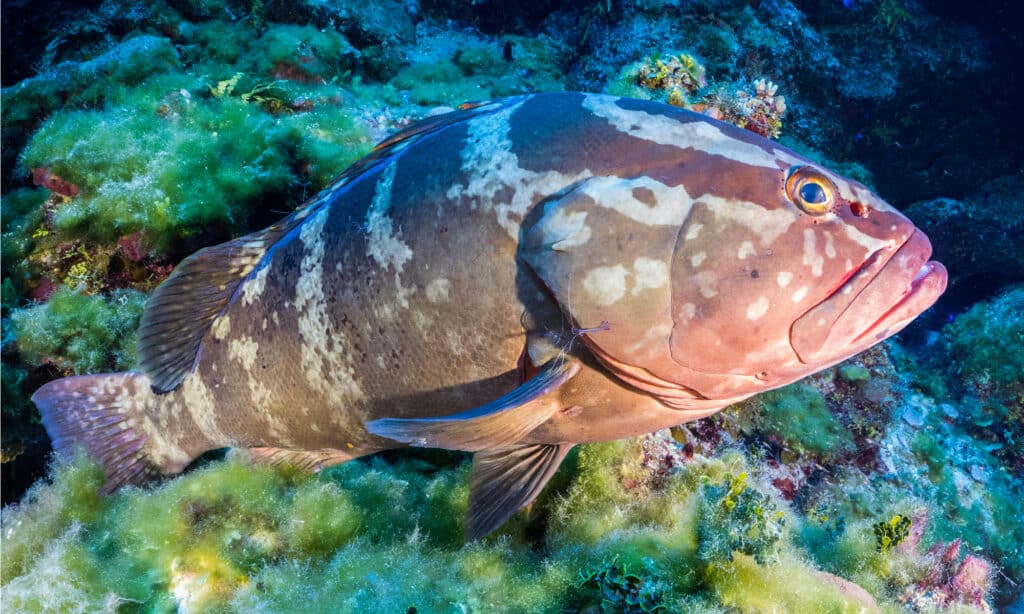
Nassau
grouper
is one of 159 species of grouper fish.
©Drew McArthur/Shutterstock.com
According to the International Union for Conservation of Nature, this colorful species is critically endangered. They range in color from light brown to red, pink, and orange. The members of this species that live deeper down tend to be more colorful. They can grow up to 3 feet long and weigh up to 50 pounds. They are one of the largest fish to be found swimming in and around coral reefs in the Caribbean Sea.
There are a few reasons Nassau groupers are at risk of extinction. First of all, they are considered a somewhat friendly fish, even allowing approach from scuba divers. So, they don’t shy away from human interactions. They are also slow to breed, and their breeding habits make them more vulnerable. They breed in large groups in the same place around the same time of year. So they are easy to find in large numbers at that time. Because of this, there are many restrictions on fishing for Nassau grouper in the U.S., the Bahamas, and the Cayman Islands. Finally, the reef habitat that Nassau groupers prefer is on the decline, which may be causing their dwindling population to decline even further.
3. Lionfish
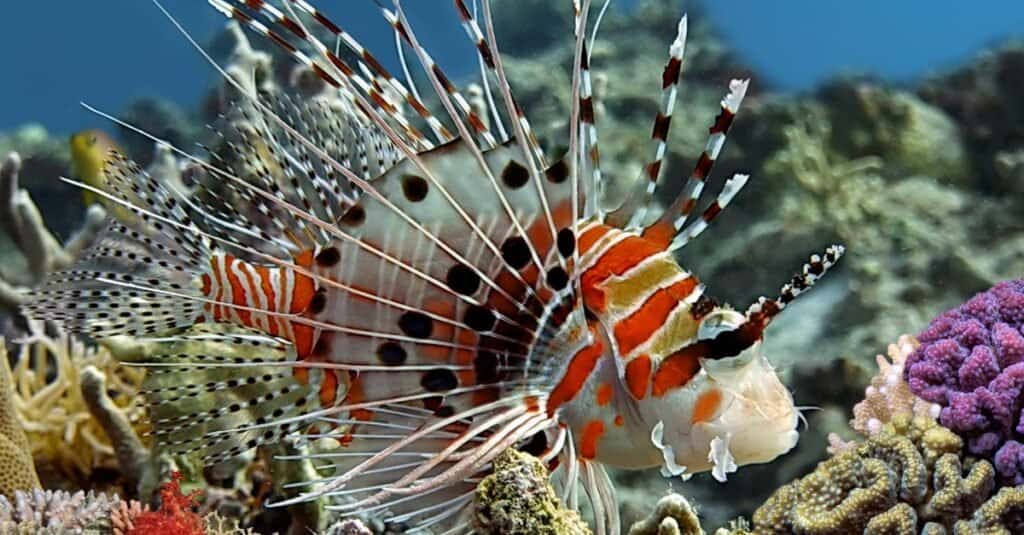
Lionfish are known for their venomous fin rays, uncommon among reef-dwelling fish along the American East Coast and the Caribbean.
©Vlad61/Shutterstock.com
Lionfish are stunningly beautiful but quite dangerous. They have red, white, and black stripes, along with spiky tendrils called fin rays extending from their bodies. They grow an average of 12-15 inches long, but have been known to reach up to 17 inches. While they are native to the Indo-Pacific ocean region, they are an invasive species in the Caribbean.
Lionfish fin rays are venomous, and these fish can sting. The stings are rarely deadly to humans, but they can be, especially if the victim is young, elderly, or sick. Even though it is generally survivable, the stings can cause a wide variety of symptoms, including:
- Pain
- Nausea
- Vomiting
- Diarrhea
- Excessive sweating
- Temporary limb paralysis
- Heart failure.
Lionfish stings have also been known to cause an anaphylaxic allergic reaction in some people.
Some experts believe that the lionfish was introduced to the area after Hurricane Andrew demolished an aquarium in 1992, causing the release of six lionfish into the ocean. However, a lionfish was found near Florida in 1985, well before this hurricane. Other experts think that the lionfish present may be the descendants of lionfish that were discarded by people with home aquariums who no longer wanted to care for the fish.
Because lionfish are so disruptive to the environments where they are invasive, a campaign to spread information about how to eat them was created by the National Oceanic and Atmospheric Administration in 2010. They even partnered with the Roman Catholic Church in one country to suggest that people should eat lionfish on Fridays during Lent, a period when Catholics do not eat meat on Fridays. Experts hope efforts like these will not only reduce the lionfish population but could also reduce the overfishing of other more endangered native fish like grouper. Despite its venomous stingers, when it is properly prepared, the fish makes a good meal!
4. Blue Tang

The palette
surgeonfish
or blue tang is the only member of its genus.
©Henner Damke/Shutterstock.com
The blue tang found in the Bahamas has a similar name to another fish that is also sometimes called blue tang but is found in the Indo-Pacific Ocean region. The Atlantic version is also called:
- Atlantic blue tang
- Blue barber
- Blue doctor
- Blue doctorfish
- Blue tang surgeonfish
- Yellow barber
- Yellow doctorfish.
They are commonly around 9 inches long, but can reach 15 inches long. These beautiful fish come in different shades of blue, from dark to light. What makes this species unique is that they are biofluorescent. That means when these fish are viewed under ultraviolet light, they appear to be a different color (green). These fish are important to the ecosystem because they can act as cleaners for other fish by eating parasites and damaged tissue.
The blue tang is not endangered because most people do not like to eat them. Their flesh does not smell good. This fish species is also prone to causing ciguatera poisoning, a type of food poisoning that you can get from eating fish that are further up the food chain. However, these fish are popular in aquariums due to their vibrant color.
5. Barracuda
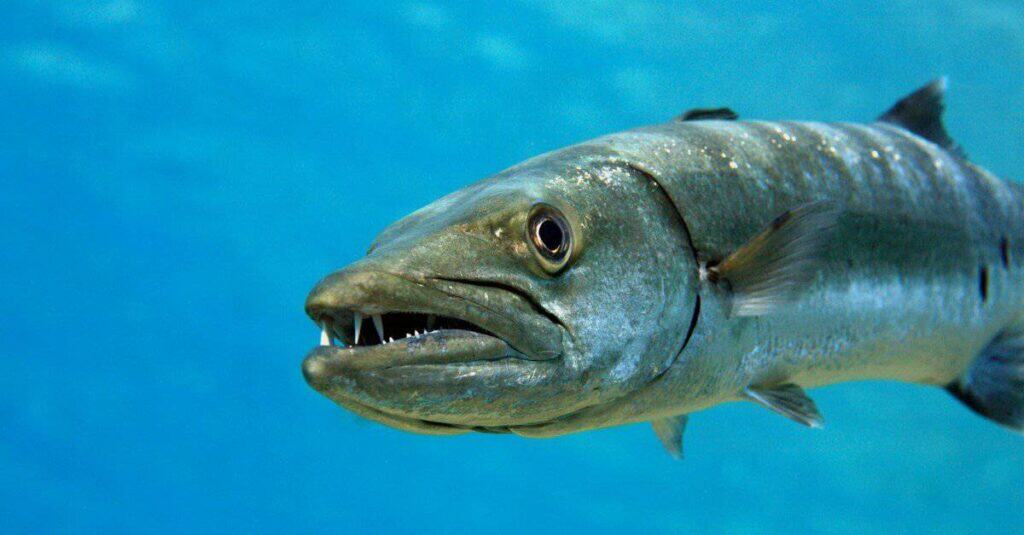
Barracudas
are adept hunters with few predators because of their speed and size.
©aquapix/Shutterstock.com
In English, barracuda is slang for a promiscuous person or a greedy person. Perhaps that is because these fish are such fierce predators, they have become associated with people who are not afraid to get what they want. There are actually 29 species of barracuda, several of which live in the Caribbean near the Bahamas.
These fish have long eel or snake-like bodies. Some species can grow up to 65 inches long. They can speed up to 27 miles per hour in short bursts when pursuing prey. Despite the fact that they are fierce predators, they pose only a minor risk to humans. Experts believe most barracuda attacks on scuba divers are a case of mistaken identity in areas with poor visibility.
These fish are popular for the sport of fishing, and in local Bahamian cuisine, where it is commonly called “Barry.” However, barracuda is notorious for carrying the ciguatera toxin mentioned with blue tangs as well. Some menus in the Bahamas even mention that you will eat “Barry” at your own risk. The toxin is rarely deadly but can cause vomiting, diarrhea, and limb weakness.
6. Blue Marlin

According to Bahamian law, all marlins caught must be returned to the water unharmed.
©Colin MacDonald/Shutterstock.com
The blue marlin in the Bahamas is specifically the Atlantic blue marlin, not to be confused with the Indo-Pacific blue marlin. It is so essential for fishing and food in the Bahamas that it is the national fish of the country and is featured on the official Bahamian coat of arms. These impressive fish have long, pointed snouts and are quite large. They can grow up to 16 feet long and weigh as much as 1,800 pounds. Because of their iconic look and size, they are considered a great prize by people who fish for sport and are also crucial for the commercial fish trade.
Due mainly to overfishing, they are listed as threatened by the IUCN and are on Greenpeace’s Seafood Red List. Surprisingly, sport fishers are some of the most fervent advocates for blue marlin conservation. They have spearheaded some conservation efforts, such as tagging programs and catch-and-release initiatives. According to Bahamian law, all marlins caught must be returned to the water unharmed.
7. Tuna
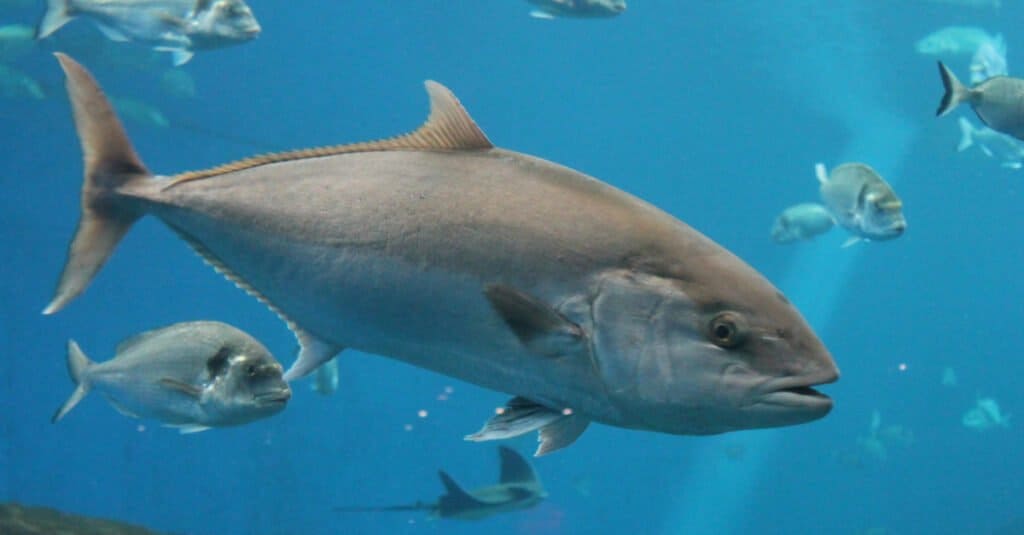
The tuna’s sleek and streamlined torpedo-shaped body makes it one of the fastest fish in the world.
©Lorna Roberts/Shutterstock.com
The Bahamas are home to several different tuna species:
- Yellowfin tuna – This tuna species can be differentiated from others by the yellow-colored tinge of its fins. These fish can weigh up to 400 pounds and measure up to 7 feet long. They are important commercially for the fish trade, and for sport fishers as well. Their numbers are still abundant enough that they are often used as a replacement for other tuna species that are on the decline. However, it should be noted that Yellowfin is on Greenpeace’s Seafood Red List because they are somewhat likely to come from fisheries with unsustainable practices. They used to be listed as critically endangered due to overfishing by the IUCN, but are now only listed as “near threatened” as populations have rebounded.
- Blackfin tuna – This is the smallest tuna species. The largest one ever caught weighed in at just 45 pounds. Even though it has a similar taste to other tuna species, it is not as popular for food. Sport fishers still enjoy the thrill of the catch when it comes to blackfin!
- Bluefin tuna – Bluefin was also moved off the IUCN’s endangered list and is now a species of the least concern. Experts credit regional fishing limits for helping to restore bluefin populations in some areas. These giant fish can grow up to 1,500 pounds. However, they are more commonly around 500 pounds. They are between 6 and 8 feet long on average. One unique fact about this fish is that it has better thermoregulation than other tuna species, which allows it to travel further north in pursuit of food.
- Skipjack tuna – Skipjack is a common fish to use for canned tuna. They swim in groups of up to 50,000 members, making them easy catches for commercial efforts. They are often just over 2 feet long and can weigh up to 22 pounds.
Summary of 7 Spectacular Fish Found in the Bahamas
Here’s a recap of the seven fantastic fish we looked at that are present in Bahamian waters.
| Number | Fish | Size |
|---|---|---|
| 1 | Bonefish | Up to 31 inches long and can weigh up to 14 pounds |
| 2 | Nassau Grouper | Up to 3 feet long and weigh up to 50 pounds |
| 3 | Lionfish | Average of 12-15 inches long; can reach up to 17 inches |
| 4 | Blue Tang | Commonly around 9 inches long, but can reach 15 inches |
| 5 | Barracuda | Some species can grow up to 65 inches long. |
| 6 | Blue Marlin | Can grow up to 16 feet long and weigh as much as 1,800 pounds |
| 7 | Tuna | Yellowfin: up to 7 feet long and weigh up to 400 pounds; Bluefin: 6-8 feet long and up to 1,500 pounds; Skipjack: over 2 feet long and up to 22 pounds |
The photo featured at the top of this post is © bearacreative/Shutterstock.com
FAQs (Frequently Asked Questions)
What are some common fish found in the Bahamas?
Tuna, blue marlin, and Nassau grouper are some fish commonly found in the Bahamas.
What is is called when you try to catch a bonefish?
Bonefishing is the sport of trying to catch bonefish.
Are lionfish dangerous?
Yes, a lionfish can sting you with venomous tendrils. The stings are rarely deadly but can cause discomfort and illness.
Can you eat lionfish?
Yes, lionfish are edible when properly filleted.
Thank you for reading! Have some feedback for us? Contact the AZ Animals editorial team.






